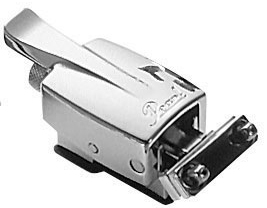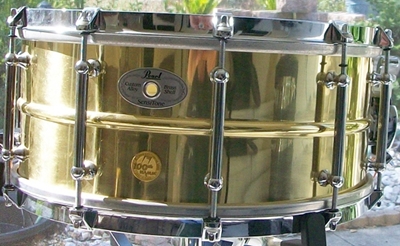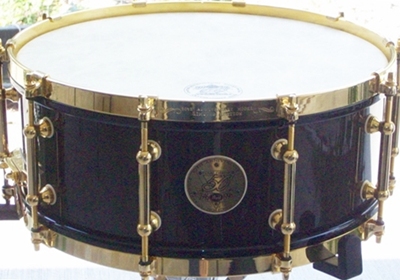In my opinion Pearl, like Ludwig, knows how to make a snare drum with mojo. I have yet to play a snare drum from either company - even their low end models - that was a dog.
My introduction to Pearl snare drums came about when I purchased a bare Pearl Sensitone steel shell off eBay. The story behind the purchase is somewhat humorous and a lesson to not drink and browse eBay. However, the finished product after I outfitted the shell with lugs, throw/butt, hoops, etc. turned out to be a great sounding (and looking) snare drum.

The only reason I sold it was it was too loud for my tastes. The rock drummer who now owns it is pleased.
My next Pearl was the Chad Smith signature model. I was pleasantly surprised by the wide tuning range and sensitivity of this instrument, which is among the low end snare drums offered by Pearl. Even with stock heads and snares it was more than adequate for jazz, blues and classic rock. One feature I especially like is the Pearl SR-015 strainer, which is a Gladstone style throwoff shown below:

Overall it is a versatile snare drum that is often overlooked because of its low price and the fact that it has a steel shell. The only reason I sold mine is because I was on a vintage snare drum quest and I had other metal shell snare drums that rendered the Chad Smith model redundant.
I next acquired a Pearl 6.5x14 brass Sensitone Special NAMM edition:

This snare drum started my love affair with Pearl Sensitone snare drums. My favorite feature is the single flange hoops with heavy duty hoop clips that give this snare drum an open sound. It works extremely well with brushes, and has a wide dynamic range from soft to loud. It also is one of the more sensitive snare drums I've owned.
I feel that you cannot go wrong with any of the many Sensitone models, but I especially like the 6.5x14 Sensitone Elite Beaded Phosphor Bronze Snare (easily the equal of my Special NAMM edition Sensitone), and the 5x14 Pearl Sensitone Elite Beaded Aluminum Snare, which sounds like a vintage Ludwig Acrolite. The 5x14 size of the aluminum model is more versatile than a deeper snare drum, and the shell gives it a wood-like sound, making it a good compromise between a metal and a wood snare drum.
My Special NAMM edition snare drum will always have a place in my snare drum arsenal, as will my Pearl 5.5x14 50th Anniversary snare drum.

I love everything about the 50th Anniversary - single flange hoops, steambent maple shell, and even the special edition Fiberskyn head. This particular snare drum proved to me that Pearl could make a wood snare drum that has the same mojo as their metal models. This led me to the 6.5x14
Pearl MHX Masters Mahogany Snare Drum, which is - in my opinion - the equal of any wood snare drum Ludwig makes (and Ludwig will always be the benchmark.) This snare drum has a 4-ply mahogany shell and 4-ply maple reinforcement rings, and is perfect for any musical style. I did not like the die cast hoops that it came with, but after throwing a set of triple flange hoops on the snare drum sang.
Bottom line: Pearl knows how to make snare drums. In my opinion you cannot go wrong with even their low end models, and their high end models are simply amazing. More importantly, every Pearl snare drum I have owned or played worked beautifully out of the box, which is refreshing considering that the first thing I do with a new snare drum is change the heads and snare wires.



